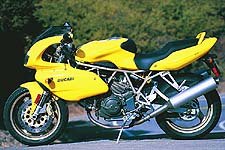Ducati Supersport 750 - Motorcycle.com
One High Concept Ride
LOS ANGELES, October 26, 1999
Ducati's are different -- just look at them. It is not just their aggressive appearance either.
There are no high-tech materials to gawk at; only retro chrome-moly steel, some aluminum and other simple alloys. Yet, drawing on their decades of experience, Ducati has -- once again -- introduced to us a bike that stirs the soul in the purest sense.
A generous mix of technological engineering is mixed with good old-fashioned know-how in the Ducati 750 Supersport, resulting in a bike that is far greater than the sum of its parts would ever let on.
Being on a Ducati, we never get tired of being asked whether or not we like the bike. We like attention and this bike draws it in spades. Nevertheless, when asked to justify our opinion, we are always hard-pressed to support our statements with facts like we are usually able to do. The way you fall in love with this bike is not by staring at peak dyno numbers, a spec-sheet or even the beautifully hand-welded trellis frame and inverted forks. You fall in love with this bike by doing to it what very few bikes appreciate -- you ride it hard.
A generous mix of technological engineering is mixed with good old-fashion know-how in the Ducati 750 Supersport.
The dual four-piston Brembo brakes are superb stoppers, bringing the bike down from any speed with control and minimal fade. The forks are inverted, 43 mm pieces with 4.7 inches of suspension travel. Even though the forks are not adjustable, our only complaint is that they are set-up for racetrack use. They are stiff with a fast rebound setting, set with 3.9 inches of trail and a 24° rake. This means that this bike prefers to be used as a tool of canyon strafing hyginks rather than as a commuter or a long-distance sport tourer. In fact, two consecutive 100 plus mile days proved this fact. A sore back and butt merely restated that this bike does not like to plod along over the super-slab.
Looking behind the 3.5 x 17 inch front wheel, the 90° fuel-injected V-twin engine has a commanding sound. Much more a roar than a purr, the engine likes to be revved throughout its range. Although the tachometer does not display it, the 750 Supersport has a red-line of 9,000 rpm. Unfortunately, the 748cc motor shakes hard below 4,000 rpm and does not have much power above 8,400 rpm.
The rear suspension is adjustable for preload and features a progressive direct linkage. This allows for an almost constant suspension response throughout the shock's 2.8 inches of travel. We found the rear shock to be complimentary to the front. It allowed stable cornering at all speeds and in all but the bumpiest corners. Mounted on one side of the three-spoke alloy rim is a 245 mm disc bound by a single pot caliper. The rear brake is also activated by an off-pivot lever. On our test bike, a loud humming sound could be heard whenever we dragged the rear brake at low speeds. Although the brake did not seem to be defective in any way the hum sounded distracting.
While riding the bike, you must remember that counter-steering is almost counter-productive. You will not realize the full potential of this Italian machine unless you use body steering. Once that's settled, you will be rewarded with a bike that is responsive and easy to ride. Leaning into turns, we noticed that the 55.3-inch wheelbase contributed toward a stable ride. That, combined with the steering geometry, allows the rider to corner with surprising confidence.
Where does this bike fit in the sport bike food-chain? We feel it would be hard pressed to be used in direct competition against its sportier brother the 748. Rather we think it would be a great match up against such bikes as the Suzuki SV650, if MSRP isn't a factor. Another use for this bike was discovered unexpectedly. As one of our rookie staff riders took it for a spin, he soon realized that he could lean lower, brake later and generally work the bike harder then any other bike he had ridden. In essence, it is a wonderful learning tool, and with its mild motor and steady handling, it is almost impossible to do it wrong.
Specifications
Manufacturer: DucatiModel: Supersport 750Price: .295 USD (Half Fairing), ,995 (Full Fairing)Engine: 90°, V-twinCompression ratio: 9:1Bore and Stroke: 88 x 61.5 mmDisplacement: 748ccFuel Delivery: Marelli CPU 1.5 EFITransmission: 5 speed, constant meshTires/Front: 120/70 ZR 17Tires/Rear: 160/60 ZR 17Wheelbase: 55.3 inchesSeat Height: 33.5 inchesFuel Capacity: 4.2 galClaimed Dry Weight: 403 lbs. (183 kg)
More by Motorcycle Online Staff





































Comments
Join the conversation